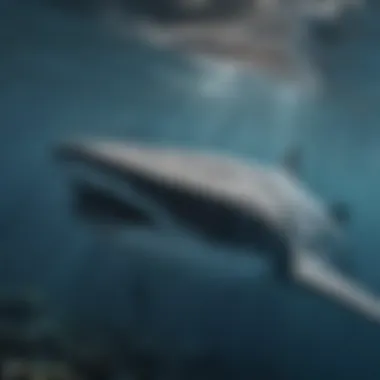Understanding the Appearance of Whale Sharks


Nature Topic Overview
Whale sharks, known scientifically as Rhincodon typus, are the giants of the ocean. This species holds the title of the largest fish in the world, growing over 40 feet long in some cases. Their massive size often catches the attention of marine enthusiasts and scientists alike. But what makes these creatures truly remarkable is not just their size, but also their unique appearance and adaptations. In this article, we will delve into the distinct physical characteristics of whale sharks, including their unique coloration, body structure, and the fascinating reasons behind these features. Understanding how and why these adaptations have developed is crucial for appreciating the biological significance of this majestic creature in our oceans.
Fun Facts and Trivia
Learning about whale sharks can be fun! Here are some interesting facts:
- Whale sharks are not actually whales; they are fish, despite their name.
- They have a distinct pattern of spots and stripes on their skin, similar to human fingerprints.
- Whale sharks primarily feed on plankton through a process called filter feeding.
- They have a lifespan of around 70-100 years, making them long-lived creatures.
These fun facts highlight the uniqueness of whale sharks. Including visuals and interactive elements like quizzes about these creatures can engage young readers and encourage curiosity about marine life.
Wildlife Explorations
Whale sharks share their ocean habitat with many other fascinating species. For example:
- Hammerhead Sharks: Known for their unique head shape, they can be spotted in similar warm waters.
- Mantas: These graceful creatures also perform filter feeding, similar to whale sharks.
Exploring the diverse ecosystem where these animals live helps to understand their roles in marine life. To enhance engagement, interactive features such as puzzles or quizzes can be added to test knowledge about these marine creatures.
Environmental Awareness
Conservation of whale sharks is vital due to their vulnerable status. Human activities like fishing and pollution threaten their populations. It is important for young readers to recognize the role they can play in keeping oceans healthy. Here are some tips for kids to help:
- Reduce plastic use to decrease ocean pollution.
- Participate in beach clean-ups with family or school.
- Learn and share information about whale sharks and other marine species.
By fostering an awareness of environmental issues, we can nurture the next generation of ocean protectors.
DIY Nature Activities
Hands-on activities can spark interest in marine life. Here are some suggested activities:
- Create a Whale Shark Model: Use cardboard and paint to make a life-size model of a whale shark.
- Spot Count Craft: Use stickers or paint to mimic the unique patterns of whale sharks.
- Underwater Exploration: Go on a nature walk to observe local water bodies and discuss their ecosystems.
Each activity can provide a practical way to learn more about marine life while having fun.
Whale sharks are gentle giants, reminding us of the beauty of diversity in our oceans.
Preface to Whale Sharks
Whale sharks hold a prominent place in the marine ecosystem. As the largest fish species in the world, they present unique physical characteristics that are both fascinating and significant for scientists and ocean enthusiasts alike. Understanding these characteristics goes beyond mere observation; it unveils insights into their behavior, habitats, and the roles they play in oceanic health.
Exploring whale sharks also allows for a deeper appreciation of biodiversity in our oceans. By learning about their physical traits and adaptations, we can grasp the complexities of their existence and survival. Whale sharks are remarkable not just because of their size, but also due to their distinctive features, which make them an important subject of study in marine biology.
In this section, we will highlight two essential aspects: an overview of whale sharks and the importance of studying them. These elements lay a solid foundation for understanding why these creatures capture the interest of many, including young learners, scientists, and conservationists.
Overview of Whale Sharks
Whale sharks, scientifically known as Rhincodon typus, are gentle giants that can grow up to 40 feet long or more. With a wide, flat head and a large mouth, they have evolved to graze primarily on plankton, making them filter feeders. Unlike the feared predatory sharks, whale sharks are not a threat to humans, often swimming at a leisurely pace. They inhabit warm ocean waters and can be found in tropical and subtropical regions worldwide.
These sharks have a distinctive spotted pattern covering their bodies, which serves as a form of camouflage in the ocean. Each whale shark has a unique pattern, similar to a fingerprint, which helps researchers identify individual sharks over time.
Importance of Studying Whale Sharks


Studying whale sharks is crucial for several reasons:
- Ecological Indicators: Their presence indicates a healthy marine environment. They are often found in areas rich in marine biodiversity, suggesting that their habitats are well-preserved.
- Conservation Awareness: Whale sharks are classified as endangered due to several threats, including fishing practices and habitat loss. Understanding their biology and ecology can aid in conservation efforts.
- Cultural Significance: In many cultures, whale sharks symbolize the health of marine habitats. Educating about these creatures helps raise awareness about the need for marine conservation.
"Whale sharks illuminate our understanding of marine ecosystems and highlight the urgent need for conservation efforts across the globe."
By familiarizing ourselves with whale sharks, we can foster empathy and understanding. This knowledge is essential, particularly for young audiences, as they learn the significance of protecting our oceans and their inhabitants.
Physical Characteristics
Understanding the physical characteristics of whale sharks is vital for several reasons. These elements not only illustrate their distinction among fish but also help us understand how they adapt to their marine environments. The unique physical traits of whale sharks contribute to their survival and ecological role in the oceans. By exploring these characteristics, we can appreciate why whale sharks are classified as a vulnerable species and the need for effective conservation efforts.
Size and Dimensions
Whale sharks are the largest fish in the world, with sizes that can reach over 40 feet (12 meters) in length, depending on various factors. Some recorded instances suggest that some individuals can exceed even 60 feet (18 meters). Their weight can surpass 20 tons. This immense size allows them to be distinctive in their habitat.
Moreover, size in whale sharks signifies not only their age but also their reproductive status. Larger females usually breed. One of the fascinating aspects here is that the growth rate is affected by environmental conditions like food availability and water temperature. This information provides insight into their biological needs and how habitat preservation can affect their populations.
Body Shape and Structure
The body of a whale shark is robust and streamlined, designed for efficient swimming. The broad, flat head is a notable feature, which aids in foraging for food. This structure is essential for navigating open oceans while hunting tiny prey.
Their wide mouth, which can be up to five feet (1.5 meters) across, is another key characteristic. It plays a significant role during feeding. The mouth is positioned at the front of the head, enabling them to take in large volumes of water. Studies show that this anatomical feature helps whale sharks filter feed on plankton, their primary source of nutrition.
Distinctive Features
The most notable features of whale sharks are their unique patterns and markings.
Rosette Patterns
Rosette patterns are a significant characteristic of whale sharks. These patterns are unique to each individual, much like fingerprints. They consist of light spots against a darker background. This striking appearance is not just for aesthetics; it may help with camouflage. The combinations of spots and lines can break up the outline of the whale shark when it swims in the sunlight.
Each pattern allows researchers to identify and track individual sharks in the wild. Understanding these patterns also helps in assessing population dynamics and movements, which is essential for conservation efforts.
Coloration and Camouflage
Coloration in whale sharks is typically a combination of dark gray and white patterns. This color scheme serves an essential function. The dark coloration helps them absorb sunlight, regulating their body temperature. Meanwhile, the lighter spots provide shadowing effects that blend into the ocean waters. This effect reduces visibility to prey and predators alike.
Coloration plays a vital role in the whale shark's adaptability to various marine environments. It also provides a fascinating area of study for marine biologists observing behavior under different light conditions.
Gills and Breathing Mechanism
Whale sharks possess five pairs of gills located on each side of their bodies. This structure is crucial for their survival, allowing them to extract oxygen from the water while swimming. Unlike many fish, whale sharks can actively pump water over their gills, even when stationary. This ability gives them the flexibility to remain still in the water to feed or rest.
The efficiency of their gills is remarkable. With a large volume of water filtered through their systems, they can support their massive size and energy needs. Understanding this mechanism not only informs us about their biology but also aids in designing better conservation techniques to protect their natural habitats.
"To understand the adaptations of a species is to unlock the secrets of its survival in the wild."
In summary, exploring the physical characteristics of whale sharks uncovers their unique adaptations and biological significance. Understanding these traits is essential for promoting awareness and conservation of this remarkable species.
Comparative Anatomy
Comparative anatomy is the study of the similarities and differences in the anatomy of different species. This field plays a critical role in understanding whale sharks as it enables us to highlight their unique physical traits in relation to other fish, especially sharks. The significance of comparative anatomy in this context lies in several aspects:


- Identifying Biological Adaptations: By examining how whale sharks compare to other sharks, we can identify adaptations that help them survive in their specific environments.
- Understanding Evolutionary Relationships: It sheds light on how these traits developed over time, revealing their evolutionary history.
- Informing Conservation Efforts: Knowledge gained from comparative anatomy aids in formulating effective conservation strategies since it shows how these magnificent animals fit into the broader ecosystem.
Comparison with Other Shark Species
Great White Shark
When discussing the Great White Shark, one cannot ignore its impressive size and predatory nature. The Great White is often seen as one of the most dangerous sharks. Its key characteristic is its powerful jaws, filled with sharp teeth suitable for tearing flesh. This makes it a formidable predator in the ocean, unlike the filter-feeding whale shark.
The Great White's unique aspect is its ability to sense electrical signals in the water, which helps locate prey. This feature gives it a significant advantage as a hunter. However, the powerful nature of the Great White can overshadow aspects of the whale shark’s gentle feeding strategy and social behaviors, relevant points for understanding the diversity among sharks.
Tiger Shark
The Tiger Shark presents another interesting comparison. This species is noted for its opportunistic feeding habits, consuming a wide range of prey, including fish, birds, and even other sharks. The characteristic feature that stands out is the tiger-like stripes on its body, especially in younger sharks. These patterns offer effective camouflage in the ocean’s waters.
A unique trait of the Tiger Shark is its strong jaws, also equipped with sharp teeth, enabling it to tackle a diverse diet. However, the Tiger Shark's hunting method differs significantly from the whale shark's filter feeding, offering insight into the various ecological niches sharks occupy.
Differences from Other Fish Species
Whale sharks, along with other sharks, exhibit distinct differences when compared to bony fish. One of the primary characteristics is their skeletal structure. Unlike bony fish, whale sharks possess a skeleton made of cartilage. This design contributes to their buoyancy in water.
Also, whale sharks breathe through their gills, allowing them to filter feed by drawing in large volumes of water. Their size also sets them apart from most other fish species. While many fish are smaller and equipped with different feeding mechanisms, whale sharks are the largest fish known to exist, making their body structure particularly fascinating to observe.
Habitat and Behavior
Understanding the habitat and behavior of whale sharks is crucial in appreciating their role in marine ecosystems. These large fish, while often gentle and slow-moving, play an essential part in the oceanic food web and the health of marine environments.
Preferred Oceanic Environments
Whale sharks tend to inhabit tropical and warm temperate waters. They are found in coastal areas, near the surface of oceans where they can easily access food. This species prefers environments such as coral reefs and open waters. They are often seen in areas rich in plankton, as this is a fundamental part of their diet. The following are important aspects regarding their preferred habitats:
- Warm Waters: Whale sharks thrive in temperatures ranging from 21 to 30 degrees Celsius.
- Coastal Regions: These environments provide access to abundant food supplies.
- Depth Range: While they can dive to deep depths, whale sharks are usually found at shallower depths.
Feeding Mechanisms and Diet
Whale sharks are filter feeders, which means they eat by swimming with their mouths open and collecting food from the water. Their primary diet consists of:
- Plankton: Small organisms, such as tiny shrimp and larvae.
- Small Fish: Occasionally, whale sharks may consume small fish that fit in their mouths.
- Fish Eggs: During specific seasons, they may also feed on eggs released into the water.
To capture their food, whale sharks utilize a unique technique. They employ a method called ram filtering, where they swim forward and allow water to flow into their mouths, filtering out food particles with their gill rakers.
Migration Patterns
Whale sharks are known for their migratory behavior. They travel vast distances across oceans depending on several factors. Some key points regarding their migration include:
- Seasonal Movements: Whale sharks often migrate to specific areas during particular seasons for feeding or breeding.
- Patterns of Travel: Their journeys can cover thousands of kilometers, searching for new feeding grounds.
- Tracking Technology: Researchers have been using satellite tags to monitor these migration patterns, providing valuable data on their habits.
Migratory routes help scientists understand whale shark populations and their movements, which is vital for their conservation.
Examining these elements of habitat and behavior provides insight into how whale sharks interact within their environments. The welfare of these remarkable creatures relies on the delicate balance of their oceanic ecosystem.
Conservation Status
Understanding the conservation status of whale sharks is crucial for elevating awareness of their challenges and the need for protective measures. As the largest fish in the world, their presence supports marine ecosystems. Consequently, their decline can have broader implications for ocean health. Educating both children and adults about these issues promotes an engaged community that values the preservation of wildlife.


Threats to Whale Sharks
Whale sharks face multiple threats that contribute to their declining populations. Two primary factors include fishing practices and habitat destruction.
Fishing Practices
Fishing practices pose a significant threat to whale sharks. Many fishing techniques unintentionally capture these gentle giants. Longlines, gillnets, and trawling are common in regions where whale sharks are found. Fishermen often do not target them, yet many are caught as bycatch. This captures not only adult whale sharks but also young ones, disrupting their reproductive potential.
One key characteristic of fishing practices is the demand for shark fins. The trade for fins leads to increased fishing pressure on shark species. Unfortunately, whale sharks also fall victim to this demand as they might be caught alongside other sharks. A unique feature of some of these practices is their reliance on specific fishing zones that overlap with whale shark habitats. This results in their depletion and the loss of important breeding grounds.
Thus, the main disadvantages of current fishing practices are evident. They lead to the population decrease of whale sharks and disrupt marine ecosystems, which rely on their presence for balancing various species.
Habitat Destruction
Habitat destruction is another critical factor affecting whale sharks. As coastal areas are developed for tourism and urbanization, the natural breeding grounds of whale sharks are being obliterated. Coastal development can cause pollution and change water habitats, which are necessary for the whales to thrive.
One of the key characteristics here is that whale sharks depend on clean oceanic environments. Many marine areas that support the growth of plankton, their primary food source, face degradation from human activity. A unique feature of this destruction is the direct correlation between human presence and environmental degradation. As humans encroach further into marine territories, the intricate balance of these ecosystems gets disrupted.
The disadvantages of habitat destruction translate into loss of breeding grounds, decreasing food sources, and overall higher mortality rates. It underscores the urgency for marine conservation securing vital habitats for whale sharks to survive.
Conservation Efforts
Fortunately, several conservation efforts are underway to protect whale sharks. Initiatives vary from local to global scales and aim to mitigate the threats they face.
- Protected Areas: Various governments have established marine protected areas where fishing is restricted or prohibited. This allows whale shark populations to recover in safe zones.
- Research Programs: many organizations focus on studying whale shark migration patterns. Monitoring movements helps identify crucial habitats and develop targeted conservation strategies.
- Public Awareness Campaigns: By educating communities and potential tourists about whale sharks, programs help reduce harmful interactions and promote sustainable practices.
"The preservation of whale sharks is essential for maintaining the health of marine ecosystems and ensuring the future of our oceans."
Overall, understanding the conservation status of whale sharks combines knowledge about threats and highlighting the efforts undertaken to secure their future. It inspires action among individuals, influencing policy changes and raising awareness both locally and globally.
Fascinating Facts
Lifespan and Reproduction
Whale sharks are remarkable in many ways, especially concerning their lifespan. They can live for over 70 years, with some estimates suggesting up to 100 years. This longevity is significant because it allows populations to withstand periods of environmental change or threats.
Regarding reproduction, whale sharks are ovoviviparous, meaning the eggs hatch inside the female, and then she gives birth to live young. Interestingly, a female can give birth to about 300 pups at once, but only a few will survive to adulthood. This high mortality rate in young sharks highlights the challenges they face in their natural environments. Monitoring patterns of reproduction helps scientists understand the species' overall health and resilience.
Cultural Significance
Beyond their biological features, whale sharks hold cultural significance in many regions. They are regarded with reverence and awe in various coastal communities. In some cultures, whale sharks symbolize strength, wisdom, and protection. Their enormous size and gentle nature often contrast with their fierce appearance, making them a source of fascination in folklore and stories.
In addition to cultural importance, whale sharks play an active role in ecotourism. Many people travel long distances to see these giants, supporting local economies. Responsible tourism encourages conservation efforts, as people gain respect and knowledge about their habitats. This connection fosters a universal appreciation for marine biodiversity and emphasizes the need to protect these majestic creatures for future generations.
Culmination
In this article, we have explored various aspects of whale sharks, their adaptations, and their appearance. Understanding the physical characteristics of whale sharks is not just for academic knowledge but also crucial in promoting their conservation. As the largest fish in the ocean, whale sharks exhibit unique traits such as their size, coloration, and distinctive patterns that make them fascinating subjects for study.
Summary of Key Points
- Whale sharks are essential to ocean ecosystems, helping regulate the populations of plankton and small fish.
- Their size can reach up to 40 feet, making them the largest species of fish in existence.
- The distinctive rosette patterns on their bodies not only aid in camouflage but also make each individual unique.
- Understanding their behavior, including feeding habits and migration, provides insight into their role in the marine food web.
- They face significant threats from human activities, such as fishing practices and habitat destruction, which highlight the need for conservation efforts.
The Role of Education in Conservation
Education plays a vital role in the conservation of whale sharks. By raising awareness about the challenges these magnificent creatures face, we can foster a sense of responsibility in our communities.
Children, parents, and teachers can help create an informed public that understands the importance of biodiversity and the need to protect it. Educational programs in schools and community centers can engage young minds, illustrating how individual actions can impact ocean health.
In summary, by understanding and appreciating whale sharks, we can contribute to their protection and promote a greater understanding of marine life. Supporting initiatives that focus on conservation and advocacy can ensure that future generations enjoy the wonders of these gentle giants.







